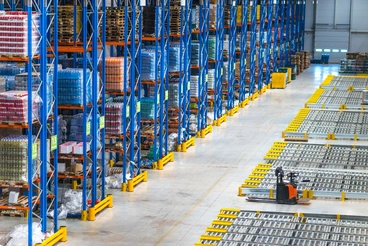Table of contents
Table of contents- How to Solve Your Wastage Problems
- An Unforgivable Sin
- Where Does Waste Come From?
- What’s the Size of the Prize?
- What Are the Main Causes of Supply Chain Waste?
- Building a Business Without Waste
- Collaboration with Your Supply Chain Partners Is a Must
- Empower Your People to Take the Right Actions
- Challenge the Status Quo Through Continuous Improvement
- Supply chain waste FAQs
According to statistics across the supply chain industry, a staggering 8% of stock ends up as waste. Of course, this is an average. Some industries have far worse numbers than others.
In the beauty industry it’s 10.2%. Within that number, 6.2% is due to overproduction and 4% comes from perished or damaged goods.
Surprisingly, it’s even higher than the food industry. While it naturally suffers from a higher degree of perishable items, accounting for 7.1% of the total, it doesn’t over produce to the same degree (just 2.9%), making up a total of 10%.
The question for these industries must be, with the dawn of AI and big data insights at the beck and call of those with the purse strings, how can these numbers be so high?
An Unforgivable Sin
Having such high numbers of waste in your business is a problem. You’ll know without looking what 10% of wasted stock is worth to your business. Wantonly throwing away stock means lost revenue and lost profits.
Think what you could do with an extra 10%. Think about where you could invest that money. And what that investment could turn into. For some businesses, that 10% might mean the difference between black and red. Open or closed.
But there’s also a sustainability issue associated with this too.
I’m sure, like most businesses, you take great care to show you’re a sustainable business that cares about the world and its future. But allowing wastage of such a high scale doesn’t ring true with the message.
The worst part of all of this? Waste is a very avoidable problem. It might be something many businesses consider ‘par for the course’. But it shouldn’t be for you. And if you take a stand against this assumption, you might well find a huge competitive advantage against your competitors.
Where Does Waste Come From?
Supply chain waste doesn’t just come from throwing away the occasional broken or out of date product. And we’re not just talking about landfill either. In fact, there are seven different types of waste.
1. Transportation
The unnecessary movement of goods, materials, or products between locations causes a massive amount of unnecessary pollution. It means fuel burned needlessly and gases and fumes put into the atmosphere for absolutely no reason.
Not only will this lead to increased costs for your business but potential damage too. For your business, and the environment.
2. Inventory
Excess inventory beyond immediate production or customer demand is one of the more obvious examples of waste. And this is one you’ll be able to see with your own eyes in the warehouse, whenever you venture down there.
Excess inventory ties up much needed capital, takes up valuable space, and drains your resources unnecessarily. So much for being lean.
3. Motion
Moving sporadically might be a good idea for your personal health, but it’s criminal to do so in business.
The wasted movement of people, equipment, or materials will have a huge impact on the amount of money you spend to facilitate it. It might also affect morale. No one likes doing things for the sake of it. And purpose plays a big part in job satisfaction.
In fact, wasting your staff’s time might be the worst waste of all.
You’ll gain inefficiencies, produce more errors, and increase safety hazards.
4. Waiting
Lots of businesses have to wait idly for missed shipments or supply issues. But wasting time because of equipment breakdowns or inefficient scheduling is avoidable and shows a lack of control.
Wasting time will decrease productivity in your business and produce huge lead times that ultimately needn’t be an issue.
5. Overproduction
Some industries, like the beauty industry, purposely overproduce. These companies might know they need buffers in safety stock, should marketing campaigns produce spikes in demand. But consistently overproducing to the degree you have an annual 10%+ wastage is an issue.
This should shine a light on your lack of forecasting capabilities.
Yes, sometimes safety stock is the right focus. But constantly producing more goods or materials than you need isn’t.
Left unabated, you’ll see excess inventory, higher storage costs, and the risk of obsolescence.
6. Overprocessing
Performing unnecessary or redundant tasks is another form of waste. Similar to wasting time, this will have a detrimental impact on the psyche of your team.
If you waste time, resources, and energy without adding value, you might find your staff looking for an employer who values their time and abilities to a higher degree.
7. Defects
Quality, or the lack thereof, hits most businesses. Defects in your products isn’t a problem unique to you. But it’s the degree of the problem that you need to keep an eye on.
You’ll often experience quality issues, errors, or defects in your products or materials.
But what impact does this have? Do you know? And do you know how much of a knock-on effect this is having? It might mean reworks, repairs, disposals, increased costs, and delays.
Sadly, each one of those outcomes can be hugely disruptive. And each one will probably cost you and your business dearly.
What’s the Size of the Prize?
To look at the savings on offer if you tackle your wastage problems, Louise Lyle from Bidfood shares her insights in the video below.
She talks about their investment in technology and the value in seeing the problem as a whole, rather than re actively managing waste week to week.
Their focus is on making their processes easier and their people’s lives easier and therefore finding better results. For this, technology can play a huge part.
You can listen to Louise’s insights and the savings and strides forward Bidfood are making on the video below.
What Are the Main Causes of Supply Chain Waste?
You may know the reason you have wastage throughout your supply chain. If you don’t, taking the time to understand where it comes from will be an enlightening exercise.
It might be human error, poor data, shifting customer expectations, the adoption of new technology, or simply holding on to technology that’s out of date.
Below, we’ll show you how you can:
- Create visibility to make good decisions
- Work with your supply chain partners to eliminate waste
- Empower your people to take the right actions
- Challenge the status quo through continuous improvement
Building a Business Without Waste
There are many examples in the supply chain showing how visibility can help you make better decisions. Reducing or eliminating waste is very much one of those examples.
The issue is that most businesses operate without suitable levels of visibility. This makes their planning and analysis totally reactive. And reduces the possibility of proactive planning to the realm of ‘nice ideas on paper’.
Critical decisions then are made without insight, data, or forethought.
The solution for you is probably looking further into the future, by utilising technology to spot problems in advance, so you can take proactive steps to stop them happening again.
Being responsive to immediate issues will help you identify waste risk issues sooner. You’ll also be able to ignore the chaos of a vast product assortment and focus your time where it’s needed most.
Not having the full picture simply means you’re giving yourself too much to do. And lying the blame at your staff’s door will only compound the problem even further.
Try to create a clearer picture of your inventory requirements, so you and your team have the best possible chance of reacting.
To do this, embrace AI. You’ll create more accurate forecasting models and be one step ahead of the game.
Strive for greater clarity on your true inventory needs, which will lead to less waste, better profits, and an improved bottom line.
Align supply more closely to demand. By doing this, you’ll reduce your risk of over ordering and find a leaner and more effective operation from top to bottom.
It’s about being both reactive and proactive. Reactive in rising to unexpected challenges in the present, and proactive in taking strategic steps to avoid waste long before it happens.
Collaboration with Your Supply Chain Partners Is a Must
Yes, you can work in isolation and deliver waste improvements. But it’s only tackling half the problem.
Work together with your supplier and you’ll address the wider issues. And that goes for most problems in your business.
Waste is a supply chain-wide community problem.
Make sure you share information with your suppliers and you’ll create network-wide visibility. You’ll be able to track real performance issues and monitor them from a macro perspective.
You can’t protect the long-term future of your business by simply covering the cracks with more stock, more orders, and more expedited deliveries. Do so, and you’ll simply create more waste.
The fact is, the whole supply chain can do a lot more, with a lot less.
Empower Your People to Take the Right Actions
Human error accounts for 10.9% of all food waste – these findings will be published in the journal Annals of Operations Research.
This is second only to the losses recorded from product change.
This is a problem that’s almost certainly avoidable by creating accountability from your staff. If you’re able to build their knowledge and skills, they’ll make better decisions that will help you address your waste issues head on.
Create forums where your people can share their issues and challenge waste with S&OP.
The momentum you’ll find here is dramatic. Your waste reduction goals are important for every person in your company. Make sure they know this and why the goals are important to them too.
Challenge the Status Quo Through Continuous Improvement
There’s always scope for improvement. Pursuing that on a continuous basis will lead to change. Going from 60% perfect to 98% perfect could be really easy.
But going from 98% to 99% might be difficult and costly.
You must pick your battles in business. Continuously reviewing your operation and identifying new areas for waste reduction will pay off considerably in the long term. We come back to it a lot, but technology can make huge strides alongside the collaboration of your people.
Pursue the alignment between your business goals and your operational execution.
Waste is an issue in your business. The stats tell us as much.
So keep waste at the top of your business agenda and ensure waste reduction complements every one of your company’s goals.
It’ll help your business growth, your customer service improvement, your margin increases, your brand, your sustainability goals, and the strength of your business when facing tomorrow’s problems.
Supply chain waste FAQs
What percentage of inventory ends up as landfill waste?
On average, 8% of stock ends up as waste across the supply chain industry.
How does waste impact businesses financially?
Supply chain waste results in lost revenue and avoidable costs, both of which negatively impact profits.
What are the seven types of supply chain waste?
The seven types of waste are transportation, inventory, motion, waiting, overproduction, overprocessing, and defects.
How can AI-powered technology help reduce supply chain waste?
Technology can help businesses spot problems in advance, allowing for proactive steps to reduce waste, improve forecasting accuracy, and align supply closer with demand.
Why is collaboration with supply chain partners important in waste reduction?
Collaborating with supply chain partners helps address wider issues and creates network-wide visibility, leading to more effective waste reduction strategies.
How can businesses empower their employees to address waste?
By building their knowledge and skills, creating forums for sharing issues, and fostering accountability through S&OP (Sales and Operations Planning).
Why is continuous improvement important in waste reduction efforts?
Continuous improvement allows businesses to identify new areas for waste reduction, leading to long-term benefits in efficiency and effectiveness.




